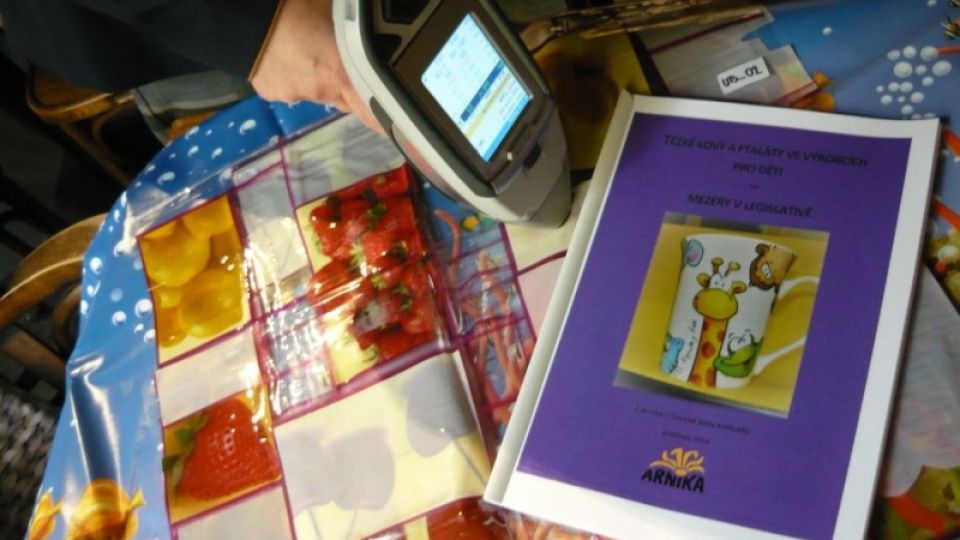What should you surely avoid on Christmas? For example, tablecloths made of PVC, especially if you have children. Organisms of children are sensitive to negative effects of substances such as phthalates and heavy metals. Their contents are substantially limited in products intended for children (such as toys). However, it ensues from a new study of Arnika that children may be exposed to phthalates and heavy metals also from many other products that they come into contact with daily. Toxic substances are present in high amounts in children's shoes, and mugs and glasses for children, but our legislation does not regulate their presence there anyhow, illogically. This is confirmed also by the newest analysis of another market segment: PVC tablecloths. Presence of hazardous phthalates was proved in three of five samples. Because of that, use of selected hazardous substances should be banned in all the products. The current legislation has gaps that, to a large extent, destroy the effects of efforts to protect children against these substances.
„It is necessary to ask a fundamental question: why lead, cadmium, and phthalates, should be safer in children's shoes and dishes than the same substances in toys? How does such exposure differ? It follows from the basic logic that limitations for use of these substances should be expanded considerably,“ said Karolína Brabcová, the head of Arnika's consumer projects.
These questions are asked by a new study of the Arnika Association „Toxic Heavy Metals and Phthalates in Products for Children - Legislative Gaps“. In its conclusions, it requires that substances of the types of phthalates and heavy metals be limited by the legislation not only in toys and products intended for children, but also in all other goods children come into contact with daily. The study targets, in particular, state administration workers and legislation makers both on the European and the Czech levels.
Results of the newest analyses made by Arnika confirm this reasoning. The analyses concerned another hazardous market segment: tablecloths and placemats made of PVC. They are still popular and thanks to their properties (especially because they may be washed easily) they are often intended just for children. However, presence of hazardous phthalates was proved in three of five samples, especially of bis(2-ethylhexyl) phthalate (DEHP) that formed up to 20 % by weight in the case of one of the tablecloths. DEHP is classified as a substance disrupting human hormonal and reproductive systems. Similar effects are shown also by di-isononyl phthalate (DINP) that was found in one of the samples, too.
„The use of the both above-mentioned phthalates is restricted in toys, products for children. However, this is not true in the case of tablecloths and placemats. Nevertheless, these products my come into contact with food almost daily,“ wearnd Karolína Brabcová, the head of Arnika's consumer projects.
„In the study, we focused on certain groups of products children come into close contact with, that, however were not regulated by the legislation. Paradoxically, use of hazardous substances, such as lead, cadmium, and phthalates, is not much restricted, or not restricted at all, in them, in comparison with other product groups. Dishes with colour printings, often containing heavy metals, or phthalates in children's shoes, may serve as examples,“ explained Ing. Petr Válek, the study author. „The European legislation is in a permanent delay concerning banning individual substances. After the six most often used plasticizers were banned, the producers introduced new substances – other phthalates and citrates, or, optionally, terephthalates – in the case of which sufficient scientific proofs of safety do not exist, and that may be released from the products,“ added Petr Válek, the study author.
Phthalates are added into PVC as plasticizers. They ensure elasticity and flexibility of the material. In view of the gradual ban of use of certain phthalates, such as just DEHP and DINP, the PVC producers are looking for other alternatives. „Two of the tablecloths tested by us contained di-octyl terephthalate, DOTP, what is a relatively new substance used as a PVC plasticizer that seems to be less hazardous than the above-mentioned DEHP. However, the individual scientific studies did not consider the so-called cumulative effect, it means the combination of effects of different substances in our bodies. A combination of plasticizers, or substances having similar chemical structures, from various sources shows a higher health effect than one phthalate acting separately,“ added Karolína Brabcová.
Notes:
Phthalates (http://arnika.org/ftalaty ): Phthalic acid esters, or phthalates, are a group of 40 chemical substances. They are used mainly as plasticizers for PVC, but they were found also in cosmetics and paints. Some of them are not harmful, but a part of them shows negative health effects (on hormonal, reproductive, and immune systems). Because of that, their use is banned in cosmetics, toys, and products for children, in the EU (specifically, this concerns DEHP, DBP, BBP, DiNP, DnOP, DiDP).
DEHP: DEHP is used, in particular, as a plasticizer in plastic products, however, we may meet it in a broad spectrum of other products (from liquid soaps to ammunition), too. 90 % of all the DEHP consumed in the European Union is used for production of plasticized PVC. DEHP may form up to 40 % (in some cases, even more) of the final PVC product. DEHP is able to bioaccumulate in food chains; it binds to the adipose tissue. For people, DEHP consumption in food is the most hazardous. DEHP is ranked among substances possibly carcinogenic to humans (group 2B according to the International Agency for Research on Cancer, IARC), it reduces fertility, damages the endocrine system, and causes foetus mutations.
http://arnika.org/bis2-ethylhexyl-ftalat-dehp
http://arnika.org/di-isononyl-ftalat-dinp
Cumulative effect: The majority of scientific studies focus on investigating health impacts of one chemical substance. However, at least 40 different types of phthalates exist, and preliminary studies show that their effects are cumulative – a combination of phthalates from different sources has higher health impacts that one of the phthalates acting separately. Because of that, for example Denmark presented, years ago already, a legislative initiative to legislatively limit use of phthalates as a group, and not to limit specific chemical substances individually. A problem is that the industry subsequently starts to use substances with similar chemical structures in the case of which sufficient scientific studies on harmfulness do not exist yet, which may, nevertheless, have similar effects.
Terephthalate: Bis-2-ethylhexyl terephthalate (DOTP) is an artificially produced organic substance, used, in the form of a colourless viscous liquid, in particular as a PVC plasticizer. It is also added into cements, adhesives, paints, inks. It has very similar chemical properties as phthalates DEHP and DINP, the use of which is, because of their negative impacts, restricted in a number of products. In this context, DOTP is regarded as their safer alternative, and its production grows correspondingly. It has to be mentioned that the number of studies investigating DOTP impacts on organisms is much lower than in the case of DEHP and DINP. http://arnika.org/dotp







